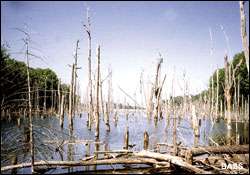
As America’s ponds and impoundments age, they gradually lose the flooded, woody cover that serves as habitat for bass, crappie and other fish species. Like a double-edged sword, this can increase catch rates for anglers, but it also eventually affects gamefish populations.
During the early stages of the reservoir-building boom in this country, resource managers and fishermen alike realized that they could supplement that disappearing habitat by sinking trees and brush. During the decades that followed, they created and utilized many other types of artificial cover.
Today, fisheries sport tire reefs, stake beds, wooden pallets, spider blocks, plastic fences, Fish ‘N Trees, Fish Habs, and an assortment of other habitat borne of creative imaginations and inexpensive materials.
“We’ve tried just about everything that’s cheap and available in quantity,” said Gene Gilliland, an Oklahoma fisheries biologist.
“Most states have experimented the same way. In North Carolina, they used 55-gallon pickle barrels.”
That’s because just about anything dropped into the water column will draw fish.
“All of these things provide substrate,” explained Hal Schramm, an ardent angler and leader of the U.S. Geological Survey’s Mississippi Cooperative Fish and Wildlife Research Unit.
“That means algae have places to grow and they attract forage species that attract bass and other predators.”
Different types of materials, structures and locations, however, possess a variety of advantages and disadvantages.
“If your goal is trying to improve nursery cover, then you want shallow, dense cover with tight spaces,” Gilliland explained. “If you want to attract bigger fish, then you want larger configurations and bigger spaces [placed] in deeper water.”
Wood is one of the cheapest and most available materials, according to Chris Horton, national director of conservation for BASS.
The only problem is, wood deteriorates and has to be replaced often, Horton added.
Tires last longer, but don’t seem to be as effective and aren’t as aesthetically pleasing.
“Plastic is also long-lived,” Horton said. “And many configurations provide a multitude of interstitial spaces that are important to fish. But they are relatively expensive and time-consuming to create.”
The Southern Division of the American Fisheries Society’s reservoir committee confirmed Horton’s observations in a nationwide survey of fisheries biologists.
Through the survey, it also compiled a manual www.sdafs.org/reservoir/manuals/habitat/main.htm that provides more information regarding the advantages and disadvantages of the various types of habitat.
“The purpose of this manual is to provide biologists, students and other interested parties with information that can optimize habitat-enhancement efforts,” the authors said.
Its findings include the following:
Stake Beds
Reasons used: low cost, effective, easy to construct and install
Advantages: users reported increased catch rates of bass, bluegill and crappie
Estimated life: 8 years
Log Cribs
Reasons used: availability of materials, low cost, preference for natural materials, longevity, ease of construction and installation, and interest of anglers
Advantages: none reported
Estimated life: 25 years
Wooden Pallets
Reasons used: low cost and availability of materials
Advantages: none reported
Disadvantages: can be heavy and difficult to move
Estimated life: 10 years
Tires
Reasons used: low cost and availability of materials
Advantages: some users reported that tires attracted largemouth bass, bluegill and yellow perch
Disadvantages: some users found the tires to be ineffective
Estimated life: 23 years
Fish ‘N Trees
Reasons used: perceived effectiveness, experimentation, longevity of materials and water quality concerns
Advantages: durability, long life and lures then not to snag in them because plastic leaves are buoyant and rotate freely
Disadvantages: cost, vulnerability to vandalism during low water, and leaves may sag as they become covered with silt
Estimated life: 6 years
Plastic Mesh-Type Structures
Reasons used: longevity, low cost, few tackle hang-ups, and availability of materials
Advantages: most users reported that structures attracted juvenile sportfish, including bass
Disadvantages: can entangle lower units and props when placed in shallow water or during low water
Estimated life: 26.7 years
Berkley Fish Habs
Reasons used: easy to construct and install, snag resistant, and often acquired and placed by local fishing clubs
Advantages: durability, longevity, attract juvenile sportfish and, to a lesser extent, harvestable-size fish
Estimated life: 58 years
Tree Felling
Reasons used: availability of materials (shoreline trees) and low cost
Advantages: do not have to be moved to the lake
Disadvantages: can lose effectiveness during low water and is subject to local, state and federal laws
Estimated life: 15 years
Submerged Trees
Reasons used: low or no cost and availability of materials
Advantages: increased angler catch rates and nursery habitat provided for young fish
Disadvantages: rather quick deterioration and tendency to snag tackle
Estimated life: 9 years

